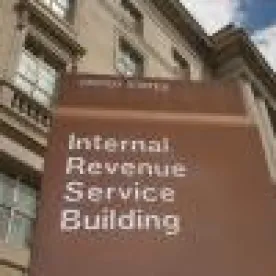When an issuer of tax-advantaged bonds discovers a problem with the bonds, the issuer can resolve the problem by requesting a closing agreement through the IRS Voluntary Closing Agreement Program (VCAP). Similarly, where the IRS discovers a problem in the course of an audit of a tax-advantaged bond issue, and the issuer agrees that there is a problem, the issuer can resolve the problem by entering into a closing agreement with the IRS.
In the closing agreement, the IRS agrees not to attempt to tax bondholders or reclaim direct payments from the issuer, and in exchange the issuer agrees to cut a check and redeem the “nonqualified” bonds.
As part of its campaign for greater consistency and standardization, the IRS has released “standard form” closing agreements for each of these situations. In VCAP, issuers or borrowers must submit a draft of the closing agreement based on this new model agreement when they submit the VCAP request (in addition to new Form 14429 and the descriptive information it requires).
Somewhat strangely, it is usually easier to get the IRS to negotiate the amount of the closing agreement payment and the amount of bonds to be redeemed than it has been to get the IRS to change the factual statements and representations in the closing agreement. The IRS has been extraordinarily resistant to even minor, common-sense changes to the terms of the closing agreement, even its boilerplate provisions. The release of the model agreements could give issuers and borrowers some additional flexibility in proposing the terms that will necessarily vary from the terms of the draft agreement, because they now will be drafting it first, at least in the VCAP context. Or, more likely, it may signal the official calcification of many of the terms; the IRS notes that if the issuer and borrower want to change the model language, it will require “additional review” by the IRS. If prior experience in negotiating the language of these agreements is any guide, we should read the phrase “additional review” as “a slight delay before telling you ‘no.'”
The model closing agreements can be found on the IRS’s website by clicking here. The webpage provides some commentary on some of the provisions. We summarize the interesting points below.
First, click here for a comparison of the provisions of the model VCAP agreement able. As you will see, most of the provisions in the two model agreements are the same.
Analysis
1. The closing agreement uses the example of an issue of tax-exempt qualified 501(c)(3) bonds.
So, in the case of garden-variety governmental use bonds, the issuer usually will remove references to “the borrower.” Other details may need to be added in the case of other private activity bonds, such as exempt facility bonds (e.g., solid waste disposal facility bonds).
Also, the agreement will need to be modified for tax-advantaged bonds that are not tax-exempt bonds, such as build America bonds.
2. The closing agreement covers only the bond issues in Recital A and only the tax problems in Recital C for those bond issues.
Recital A has a description of the bond issues that the closing agreement covers. This seems informational, but it is important. Only the bonds mentioned in Recital A will be covered by the closing agreement.
Recital C further specifies the tax problems with the bonds in Recital A that the closing agreement will resolve. This provision is also important – the closing agreement will cure only the violations listed in Recital C. If it’s not explicitly there, it’s not resolved.
Importantly, Recital C in each agreement says that the IRS “has a basis to conclude” that a violation has occurred. It does not say, for example, that a violation “has occurred.” This subtle linguistic change could prevent situations like the recently-concluded New Hampshire student loan bond saga. Under Section 7121 of the Code, which governs closing agreements, the IRS does not have to conclude that a violation has occurred before it signs a closing agreement with an issuer.
3. Recital B in the VCAP agreement describes the bond issues and the circumstances leading to the violation.
This is the Recital that will vary the most from situation to situation. Most of the information for this recital will come from the VCAP request and Form 14429.
4. Section 5 is the punchline – it notes that the closing agreement will prevent bondholders from having to include interest on the bonds in their gross income for tax purposes as a result of the violation described in Recital C.
Where applicable, the issuer and borrower should modify Section 5 to address other collateral tax consequences that will be avoided because of the closing agreement. One example, which the IRS describes on its website, is a statement about whether the facilities acquired with bond proceeds by a taxable conduit borrower will continue to be treated as tax-exempt bond financed property under Section 168(g) of the Code and continue to be subject to less taxpayer-friendly (i.e., slower) rates of depreciation. Other examples can be found in Code Section 150(b).
5. Section 7 waves a magic wand over the original proceeds of the nonqualified bonds and breaks the link between those proceeds and the expenditures the issuer originally spent them on.
Take note of Section 7. This section states that proceeds of any bond redeemed as a condition of the closing agreement are treated as unspent proceeds for any future refunding of those bonds. The IRS website makes clear that this applies not just to unspent bond proceeds of the redeemed bonds, but also to bond proceeds that were previously spent.
The IRS website describes this provision as follows: “The effect of this paragraph is to sever the connection between bond proceeds and the expenditures to which they were originally allocated. Accordingly, should a taxable refunding of the nonqualified portion of the bonds subsequently be refunded with tax advantaged bonds the proceeds would not be considered as “spent,” which could result in violations of tax rules regarding the expectation to use proceeds and certain arbitrage restrictions.”
This provision appears to be intended as an anti-abuse rule that will prevent issuers from borrowing in the taxable markets to redeem nonqualified bonds and then using tax-advantaged bonds to refund that taxable borrowing at some later date. This provision will make it quite difficult to do so, because the issuer will be treated as essentially borrowing most of the bond issue twice, which will lead to any number of nightmares.
Not to get too metaphysical, but Section 7 treats the nonqualified bonds as irredeemably nonqualified (also the title of my upcoming memoirs). To illustrate: Assume that the reason for a closing agreement for a bond issue was excessive private business use of the bond-financed property, and assume that the issuer had to redeem the nonqualified bonds, which were a portion of the issue, but not all of it. To redeem the nonqualified bonds, the issuer borrowed money in the traditional taxable markets. Now assume that soon after that, the issuer ended the private business use, so that the bond-financed property could technically be eligible for tax-exempt bond financing. Even so, Section 7 of the model closing agreement prevents the issuer from refunding the taxable borrowing with tax-exempt bonds.
6. The IRS reserves the right to audit the bonds in Section 8.
Section 8 of the VCAP agreement notes that the closing agreement isn’t based on an audit of the bonds and that the IRS reserves the right to audit the bonds. This is somewhat troubling. The point of the closing agreement is to resolve, once and for all, the tax issue described in Recital C of the agreement. This provision seems to undercut that point. It would be nice to have the agreement modified to say that the IRS will not audit the bonds and challenge their tax-exempt status as a result of the violation described in Recital C of the agreement. This provision is omitted from the audit model agreement, but it would be better to add it back in and restrict it to the issue described in Recital C.
7. Exhibit A requires a certification from the trustee that the issuer has redeemed the nonqualified bonds.
Exhibit A will be a certificate from the trustee listing the amounts and CUSIPs of the nonqualified bonds. It will also contain a certification that the bonds were redeemed on a pro rata basis, in accordance with the requirements in Reg. 1.141-12(j). Where the bonds won’t be redeemed until a date after the closing agreement is signed (for example, because the bonds aren’t yet callable), the IRS will modify this exhibit to tell the issuer how to notify the IRS that the nonqualified bonds have been redeemed.
8. Issuers and borrowers should incorporate a review of the model closing agreements into their post-issuance compliance planning.
When deciding how to approach potential violations that issuers and borrowers discover looming on the horizon, or deciding tactics in an audit, issuers should include a review of the model agreements as part of their planning process, in addition to preparing a preliminary calculation of the potential closing agreement amount and the amount of nonqualified bonds to be redeemed.




 />i
/>i
